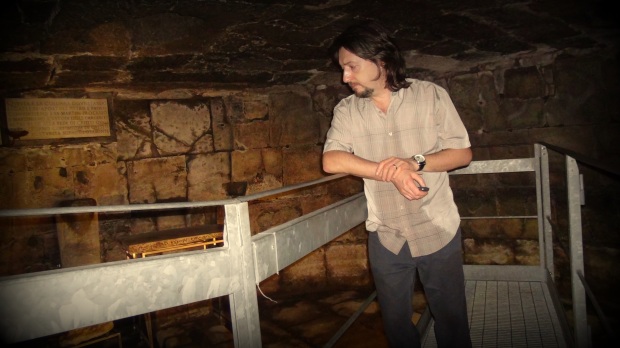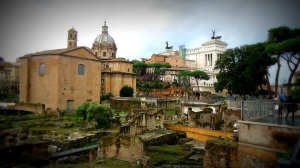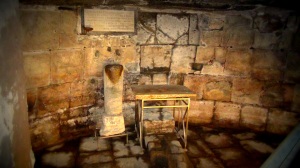Posts Tagged St Peter in Rome
Recent discoveries in the Mamertine Prison, Rome
Posted by simon peter sutherland in Biblical archaeology on August 6, 2018

Mamertine Prison, Rome © 2018 Simon Peter Sutherland
“In 2017 I revisited the Mamertine prison, and forum, Rome and explored a number of new discoveries made at the Mamertine the previous year. I believe Paul wrote 2 Timothy from that prison. I also think it possible that 2 Peter and Acts of the Apostles was written from here.
The Mamerine Prison is one of my favorite Biblical places in the world. I have visited the proposed cell of St. Paul at Philippi, I have visited St. Paul’s Grotto, Rabat, Malta, but the Mamertine has won me. It is or was, a cold, damp, dark and dingy place, and such is what I love about it. It is highly primitive. Ancient. Biblical!
In the Basilica of St. Paul outside the walls, Rome, there is an ancient ‘chain’ reputed to have been used to bind St. Paul during his time in Rome. The chain was found in the ancient tomb of St. Paul over which the Basilica was built. When I visited the basilica in 2014, I noticed in 2 Timothy 1: 16 Paul referred to his “chain”. This in the Greek and the English is in the singular. For me, it perfectly matched the description given by Paul. It also fit perfectly with the type of chain that would have been used to bind Paul at the Mamertine.
Having read through an excellent series of books entitled “The Book of Acts in its first century setting” Volume 3, Paul in Roman Custody by Brian Rapske, it is explicitly clear that the Apostolic era was a time of great suffering. Here at the Mamertine, Paul suffered greatly and wrote to Timothy about his departure being at hand (2 Timothy 4: 6). He had stood trial before Casear, probably at the Curia and Eusebius in Ecclesiastical history 2: 22, informs us it was on Paul’s second visit to Rome that he was martyred under Nero.
At the Mamertine when Paul was held there about 60 AD and later, the 2016 excavations revealed that the cell did not have an upper floor like we see today. The upper floor is only about 500 years old and was constructed into the building when it was used as a Church. The original cells were more in the format of a cave rather than a fixed upper and lower level structure. Visitors for many years have believed that Paul was lowered into the lower dungeon via the circled hole in the upper cell floor. But the 2016 excavations revealed that the entrance to the lower cell area came from the upper roof, not the upper floor. When Paul was incarcerated here before his execution, he would have been lowered into the lower dungeon from the upper roof.
This practice often left prisoners physically damaged. Sometimes the broke a leg or an arm. We do not know of the level of damage Paul suffered here, but we know that his time at the jail, within the cell, would have been to face death. Once prisoners were put in here, it was to await execution.
The excavations revealed areas not seen by the public for centuries. These areas were around the main cell, and raised somewhat. If Peter was ever held here, he would have been held in the upper cells until his trial, and when condemned, dropped into the lower cell from the upper roof to await his death.
As I previously mentioned, it is also possible that 2 Peter was written in this cell. Although some modern scholars claim that Peter never wrote 2 Peter, I disagree entirely. While in Rome I attempted to view the letter from the perspective of the ancient city. Upon my return to England I researched the letter internally and found hints of ancient Rome in the text. One of which involved the great fire of Rome, of whom Nero, by tradition, is believed to have blamed the Christians. If Peter was in Rome at the time, he too would have been accused of either arson or inciting it. This could reveal insight into his references to “fire” in 2 Peter 3: 7, 12. He may well have been using the ‘fire’ reference to provoke believers to remember that a coming judgment will bring about the destruction of the world, by “fire”. There can be little doubt from this perspective that the great fire of Rome, would have been the fresh and current hot topic of the city. If Peter was being held in the Mamertine while the great fire was fresh in the minds of the Roman people, it is not difficult to see why he used this reference to remind people of the coming greater judgment at the end of the world. This would place the composition date toward the summer/autumn of 64 AD, because the fire took place in July of that year.”
Excerpt from upcoming book by Simon Peter Sutherland
© 2018 Simon Peter Sutherland
Visit to Rome: The Mamertine Prison
Posted by simon peter sutherland in Biblical archaeology on December 1, 2014
Visiting ancient Biblical sites in the Mediterranean is always an experience for me and is something I find second to none. Although I like some of the wonders of modernity, I regard our present world as unappealing, noisy and somewhat shallow. Because of that, I prefer history rather than the present
Last month, I travelled to Rome, the ancient and modern city known for being somewhat of an open air museum. Being a history fanatic myself and absolutely intrigued by the Bible, as always I was in inner rapture.
During the afternoon of the first day I visited the ancient area of the Forum leading to a place known as “Mamertinum”or the Mamertine Prison. This ancient prison is within a stones throw of the ancient forum, a Comitium which once felt the feet of the Apostles Peter and Paul and also of Luke and of Aquila and Priscilla.
The Gospel of Luke and Acts of the Apostles were probably written while Luke was in Rome. We also know that Luke was with Paul during his time in prison. This is understood from 2 Timothy 4: 11.
The Mamertine prison, known historically as the “Tullianum”, was probably constructed between 640-616 BC and was likely a cistern. The amazing thing for me was that scripture was written from this damp dark cell.
In 2 Timothy 1: 16 Paul referred to his “chain” this chain now resides at ‘St Paul outside the walls’ which was build on his ancient tomb. Writing from the Mamertine, in 2 Timothy 2: 7-9 Paul wrote: “Consider what I say; and the Lord give thee understanding in all things. Remember that Jesus Christ of the seed of David was raised from the dead according to my gospel: Wherein I suffer trouble, as an evil doer, even unto bonds; but the word of God is not bound.”
On entry down the stairs to the upper level of the complex, I saw ancient Frescos. These can be found on the walls and show Christians depicted with the arms and hands held out. Over recent years Archaeologists have uncovered evidence that have connections to St Peter as early as 7th century. The evidence also suggesting the Mamertine was used as a Church by the 8th century.
The claim that St Peter was in Rome goes all the way back to the 1st century from his probable coded use of the word “Babylon” for Rome in 1 Peter 5: 13, 2 Peter 5: 13, and his crucifixion linked to John 21: 18 where Jesus foretold him of his future suffering. The claim of his crucifixion in Rome comes from the 1st or 2nd century “Acts of Peter” which we know was in circulation in the 2nd century. The “Acts of Peter” claims that Peter was crucified upside down in Rome at his own request. This claim is also affirmed by Clement between AD 80-98 in his letter to the Corinthians (chapter 5). An event which probably took place near where St Peter’s Basilica now stands around AD 64 during the reign of Emperor Nero.
There was a time when condemned prisoners were held in this cell before execution. We know for certain that 2 Timothy was written from the Mamertine and it is possible that Philippians was also written here too. If Peter was in fact executed in Rome then he most certainly was held in the Mamertine, as a strong tradition affirms. If that be true which I think it is, 2 Peter may also have been written in this dungeon.
Other Biblical texts possibly written from the Mamertine or nearby, include Philemon, Ephesians, Colossians and possibly Galatians. It is one of the most outstanding thoughts and realities of life that the Truth of the Gospel is that suffering produces great things. Persecution never destroys the Church, on the contrary it enhances it. It is truly amazing to think that such a light as Scripture itself could come from such a dark damp cell. That such a light could truly shine from such a dark place.
I love this little prison.


